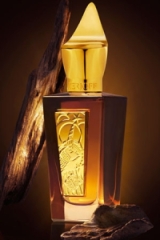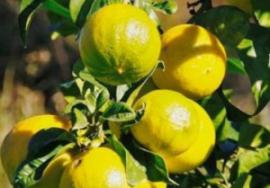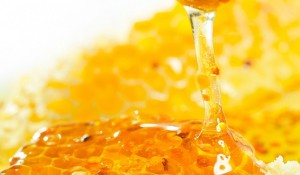
Mamluk. Source: Fragrantica.
Xerjoff is an uber-luxury, Italian niche perfume house founded in 2004 by Sergio Momo. In 2012, Xerjoff (pronounced as “Zer-joff”) launched its Oud Stars Collection of fragrances which included Mamluk, a gourmand take on agarwood. Like the rest of its siblings, Mamluk was created by the perfume house’s founder, in conjunction with Sonia Espelta and Laura Santander.
The notes in Mamluk according to Xerjoff and Luckyscent include:
Italian Bergamot, Honey, Caramel Accord, Jasmine Garndiflorum, Osmanthus, Laos Benzoin, Vanilla Madagascar, Indian Oud, Crystal Musks, and Amber.
Mamluk opens on my skin as the most unbelievably sweet bouquet of lemon and honey with a beautiful, but faint, floral tinge. Quickly, sour notes emerge, smelling rather urinous, though simultaneously infused with an incredible sugariness. Thankfully, both the sourness and the pee-like nuance are very short-lived, and fade away in a matter of minutes. In the meantime, subtle whiffs of a sharp, slightly astringent oud flicker on and off, while musk, amber, and a warm plushness stir in the base.
What’s interesting about Mamluk’s opening minutes is that, despite smelling the nuances of the individual notes, you’re subsumed by the overall effect which is far more over-reaching, all-encompassing and lovely. Yes, you can detect the lemon or the subtle florals, along with the other elements, but Mamluk envelops you in a blooming cloud that feels absolutely radiant. It’s like a giant, yellow diamond shining in the dark, throwing off rays of crystal clarity and sharpness. And, yet, there is incredible softness billowing out as well. It’s like a juxtaposition of angles but, also, of extremes that’s very hard to describe. Take, for example, that lemon and honey combination. It is so sweet, it almost hurts; so intense, it can verge on the sharp; and yet, there is a radiant softness that almost glitters.
Ten minutes into Mamluk’s development, the perfume turns even sweeter and warmer. The citrus is heady, conjuring images of the fruit lying ripe, thick, and heavy on the branch, and so sweetened by the sun that it verges on the over-blown. The subtle floral nuances are simultaneously airy, thick, gauzy, dainty, indolic, and slightly voluptuous. Again, it’s the story of contradictory extremes. In the background, the Indian oud now feels so sweetened that it almost verges on the caramelized. It’s a far cry from the medicinal, ripe cheese and fecal characteristics of the very aged, rare agarwood from Laos that dominates Mamluk’s very masculine sibling, Zafar. The overall effect of the different elements in Mamluk is an intoxicating, honeyed headiness that feels almost piercing in its sweetness and glitter.
Slowly, slowly, the sweetness starts to take some shape. Twenty minute in, the heavy honey cloud takes on a definite salty caramel undertone. There is a similar salty vibe to the musk and golden amber, leading me to believe that there may be actual ambergris — that really rare, difficult to find, incredibly expensive ingredient — in Mamluk, and not the generic sort of “amber” that is used in most perfumery. The floral notes aren’t as easy to distinguish. They feel amorphous, and never like distinct jasmine or osmanthus. In fact, I don’t smell any of osmanthus’ tea or apricot undertones, though I detect something that feels a lot like peach. Perhaps, it’s the effect of the rich honey and the lurking caramel that have made the osmanthus into something far richer than delicate apricot. Over time, the caramel becomes stronger and more powerful, infusing everything with its sugary tones. When combined with the honey, the sweetness completely overpowers and overshadows the subtle flickers of oud, which now retreats far, far to the background, never to be seen again until the drydown. At the 40-minute mark, even the flowers feel as though they’ve been drenched in caramel and, to be honest, it’s a bit cloying at this stage. Have I mentioned that Mamluk is a very sweet fragrance?
Mamluk never changes in its primary essence, only in its shape. From start to finish, it is predominantly a very sweet citrus-honey fragrance with other notes that circle around it like planets around a honeyed sun. For the first three hours, the florals are the main lady-in-waiting, though they always feel abstract and indistinct. Sometimes the floral-peach note seems a little more prominent, sometimes the caramel, but, at all times, the star of the show is the tangoed dance of honey and heavy, sun-sweetened lemon.
The only big change in this period is in Mamluk’s texture which becomes softer, warmer, smoother, lighter, and less thick. The edges have been rounded out, even blurred, so that the whole thing feels more billowy than ever. The perfume feels better balanced, particularly the sweetness which, at the start of the second hour, seems much less overwhelming. Mamluk is that oddest of combinations: a fragrance whose potent, indolic notes feel simultaneously thick and airy, strong and light, voluminous and heavy, sharp and blurry. It would almost feel like a vague cloud, except you can clearly detect those main notes — limited and monotonous as they may be.
It’s only around the fourth hour that the notes themselves start to shift their place in the rotation. Now, the oud starts to peek out from behind the sun. It’s as though it needed the power of the other notes to fade a little before it had the chance to be noticed. Taking its place in the background is the floral bouquet which becomes softer and less noticeable with every passing hour. Mamluk is now a honey-citrus perfume infused with sweetened agarwood and the barest suggestion of rich vanilla bean paste. In its final moments, Mamluk is nothing more than abstract sweetness with the vaguest suggestion of honey.
All in all, Mamluk lasted a little over 11.25 hours on my perfume-consuming skin. It’s an incredibly powerful perfume, even when its projection drops from its initial heady heights towards the end of the second hour. At that point, Mamluk only wafts 3 inches above the skin, though it is still extremely strong within that small cloud. It takes the fragrance about 7.5 hours to become a skin scent, though it doesn’t require voracious sniffing to detect it even then. For all that Mamluk sometimes feels like a billowing, radiant cloud in weight, the strength of the fragrance cannot be under-estimated. I merely dabbed, approximately 2.5 large-ish smears, and I cannot imagine the power of Mamluk if one actually sprayed it on, never mind if one sprayed on a lot. My God, they might smell you out at the space station!
I like Mamluk, though I think one could get a little bored of it and exhausted by the fierce onslaught of its richness. It’s linear, monotonous, far from complex, and, yet, it’s also pretty, lush, rich, heady, and languid. Mamluk is really a honey lover’s fragrance, and not something I’d ever recommend to those whose skin chemistry always turns the note sour, urinous, or animalic. I’m lucky and, with one single perfume exception, honey always blooms on my skin, so obviously this review reflects that aspect. As a whole, Mamluk feels quite unisex, though it may be too feminine for those men who like their agarwood on the very undiluted, masculine, edgy, raw side (like in Zafar). Mamluk is actually a perfect fragrance for those who normally struggle with oud, who like it highly tamed and sweetened, and who prefer it to be a minor, unobtrusive player instead of a main one. It’s definitely a fragrance for those who love very sweet or gourmand perfumes. For me personally, it’s a little too repetitive, one-dimensional, and boring, but I can definitely see its heady charms. Mamluk is frightfully expensive, however, and I personally think it’s actually far too expensive for its very simple nature. However, price is always a subjective issue, and Mamluk does feel opulently luxurious, so if you love honey and dislike strong oud, then you may want to give it a try.




